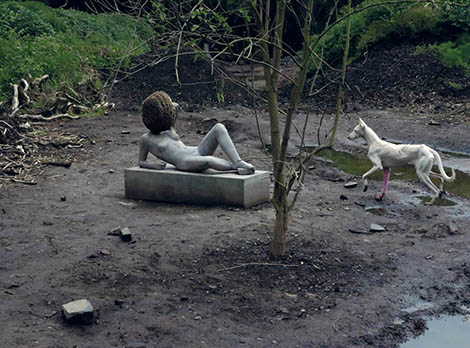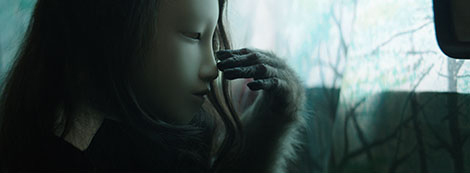The first ever retrospective of Pierre Huyghe’s work presents 50 works spanning 20 years which, like flicking through a scrapbook, provide a montage of Huyghe’s most prevalent themes, motifs and inspirations, drawn from the fields of literature, film, music, science and architecture. This is the exhibition’s third and last manifestation following stints at the Centre Pompidou in Paris and the Museum Ludwig in Cologne.
The exhibition eschews a chronological structure and is conceived as a single environment, the conditions of which allow events to unfold according to their own course. Upon arrival, each visitor is announed by The Name Announcer (2011), from which point they walk, reflect and interact in a space filled with unplanned events and un-choreographed encounters—much, as LACMA describes, like a public space such as a park. The layout of the exhibition sets the framework for exploration, beginning with a tangle of narrowing corridor-like spaces and opening out into larger, progressively brighter galleries. The Resnick Pavilion provides a calm space in which to view the works, some of which could prove hard to engage with in a more crowded setting.
Teeming with plants, animals and people, as well as performance, films, objects and drawings, the exhibition is like an ecosystem in a continual cycle of repetition and gradual change, much of which began long before this incarnation at LACMA. A number of the gallery walls have been transported from the original Pompidou exhibition, while certain of the works have been adapted specifically for this installation. Each experience is a product of timing. The light and cinematic pieces run their own rhythm, as do the living pieces and live events. On any visit the beehive sculpture Untilled (Liegender Fraunakt) (2012) may be virtually empty or teeming with inhabitants while Human (2012), the elegant Ibizan hound who periodically tours the galleries, may or may not make an appearance. The expectation of seeing Human, and of live events such as Singing in the Rain (1996) and L’Écrivain public (1995) is as much about their significance as their actual enactment.

Pierre Huyghe, Installation view of the exhibition, at the Centre Georges Pompidou,
September 2013 – January 2014, © Pierre Huyghe, Courtesy Marian Goodman Gallery, New York/Paris, Photo by Pierre Huyghe.
The exhibition strives to be non-hierarchical, and the works often interject or override one another. Light installations such as RSI, un bout de reel (2006) and Atari Light (1999) flicker to life at various intervals while videos play in their cycle, fragments of sound breaking through from one room to another: Kate Bush’s “Wuthering Heights,” or the roar of a swarm of bees. This intentional interruption of one work by another is reserved in some instances. A Journey That Wasn’t (2005) and L’Expedition scintillante, Acte 2 (Light Box) (2002) are timed to perfection, the light box display picking up in the lull following the video’s completion and providing one of the more heady experiences. Choreographed to Erik Satie’s Gymnopédies No.3 and No. 4 orchestrated by Debussy, the synchronized smoke and light system fills the darkened room with a hypnotic concoction of music, warm hues and sweet scent.
Whilst diversity abounds, the cinematic works are a central focus. The Host and the Cloud (2010), an epic experiment in a vacant ethnographic museum filmed over the course of a year, is enigmatic, surreal and at times challenging, but masterfully sustained over the two-hour duration. Untitled (Human Mask) (2014) invokes a dystopian landscape of derelict buildings in which a monkey wears the mask of a young woman. A Journey That Wasn’t (2005) stitches events together, meshing an expedition to the Antarctic with an orchestral event in New York. The cinematography is lush and sensuous, as we are taken alongside swimming whales though a vast and peaceful landscape.
Throughout, Huyghe places candid art-historical references. In one room The De Hory Modigliani (2007), a fake by the famous forger, hangs across from Zoodram 5 (2011), a live marine ecosystem starring a hermit crab whose carapace bears the face of Constantin Brancusi’s Sleeping Muse. Precambrian Explosion (2014) presents a rock suspended in a tank, referencing Rene Magritte’s Castle of the Pyrenees while in Nymphéas Transplant (14-18) (2014), Huyghe re-homes water lilies, plants and animals extracted from Claude Monet’s pond at Giverny.
Overall, Pierre Huyghe presents us with a surreal and synergistic world that is a thrill to delve into, brimming with creatures, influences and activity, packed with silence and noise, light and dark. The retrospective manages to be both mysterious and highly approachable, and poses a refreshing challenge to our impatience to absorb everything on demand.



